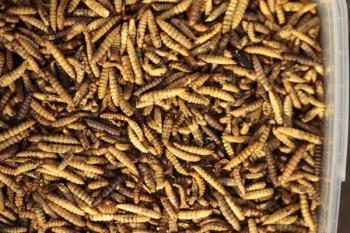
The role of fiber in weight loss diets
Dietary fiber may help dogs and cats feel fuller by diluting calories.
One of the main reasons that owners have trouble helping their dogs and cats lose weight is the difficulty in long-term compliance.1 Not surprisingly, owners cited begging for food or treats and dogs that eat food intended for other pets as common obstacles in a program to help pets lose weight.
Beth A. Flickinger, PhD, RD
Dietary fiber may help dogs and cats feel fuller by diluting calories. Fiber is essentially calorie-free, so adding fiber to a diet helps reduce the caloric density, which allows the pet to eat a larger volume of food without consuming additional calories. This larger volume of food helps contribute to gastric distension, which is one of the satiety cues that signals to the pet that it is full.
An important consideration for promoting optimal weight loss and overall well-being is the type and amount of fiber in the diet. Commercial weight loss diets for pets vary in their fermentable and nonfermentable fiber content.
Fermentable fiber
In the past, fiber was classified based on its structure as soluble or insoluble, depending on whether or not it could be dissolved in water. A newer approach is to classify fiber based on its functionality as fermentable or nonfermentable, depending on whether or not bacteria can ferment (use) the fiber. In general, soluble fiber is fermentable, and insoluble fiber is not, but since there are several exceptions to the rule, the functional classification is preferred.
Fermentable fiber, as indicated by its name, is naturally fermented by colonic bacteria in dogs and cats. In the fermenting process, nutrients called short-chain fatty acids are produced. These short-chain fatty acids, especially butyrate, are then used by the intestinal cells as an important energy source. Short-chain fatty acids have been shown to support healthy intestinal cell growth and development and to improve nutrient absorption.2 In contrast, nonfermentable fiber is poorly fermented or not fermented at all and, therefore, does not yield short-chain fatty acids and cannot help fuel the intestine.
Fermentable fiber has also been shown to promote satiety in dogs. In one study testing moderate levels of a fermentable-fiber blend of beet pulp and fructooligosac-charides (FOS), this fiber blend produced more of the satiety-signaling hormone glucagon-like peptide-1 than nonfermentable fiber did.3 Furthermore, another study demonstrated that dogs consuming a diet containing a fermentable-fiber blend not only had more of the health-promoting short-chain fatty acids, but also tended to eat less than dogs fed a diet with nonfermentable fiber.4
Nonfermentable fiber and high-fiber diets
Although nonfermentable fiber has been used as a way to dilute calories in diets for overweight animals, the total amount of fiber in some of these diets is surprising. Some diets marketed for weight loss in dogs contain nonfermentable fiber at levels that would equate to a person consuming about 12 apples plus 28 slices of whole-wheat bread daily.
Some studies have suggested that diets high in nonfermentable fiber reduce food intake, but practical evidence is lacking. Most studies have used an artificial experimental setting, such as allowing dogs to eat as much as they can, but only for a limited length of time.5 Studies like these measure how fast a dog can eat a large amount of food and the caloric-diluting effect of fiber, but they do not measure the true effect of satiety.
Studies with well-controlled experimental designs have not shown benefits of high levels of dietary fiber. One study tested high levels of fermentable and nonfermentable dietary fiber inclusion (approximately 16% on a dry matter basis) in a low-calorie wet dog food, but they did not find any benefit on food intake or weight loss in dogs.6
Importantly, feeding high levels of nonfermentable fiber has not been shown to result in more weight loss than a diet containing moderate amounts of fermentable fiber. In one study, dogs underwent a weight loss program that was based either on a diet with high levels of nonfermentable fiber (16% protein, 10% fat, 17% crude fiber, and 3.244 kcal/kg metabolizable energy) or a diet with moderate levels of fermentable fiber (29% protein, 8% fat, 4% crude fiber, and 3.509 kcal/kg metabolizable energy).7 Dogs in both groups lost the same amount of body weight, but dogs on the moderate-fiber diet lost about 50% more fat than did dogs on the high-fiber diet, as determined by body composition analysis via dual energy x-ray absorptiometry (DEXA). The researchers theorized that this was probably because moderate levels of fermentable fiber improved the dogs' ability to control glucose and insulin metabolism, which in turn aided in reducing body fat and maintaining lean muscle mass.
In addition, high levels of dietary fiber can reduce the palatability of the diet, increase stool volume and frequency, and result in poor coat and skin quality. High levels of fermentable fiber can result in flatulence, soft stools, and even diarrhea.
An optimal approach
Choosing a weight loss diet that contains moderate levels of moderately fermentable fiber is a better way to reduce the caloric content of a weight loss diet. A diet such as this provides high-quality nutrition without the risk of increased stool volume and decreased palatability that can be associated with high levels of nonfermentable fiber. Iams, Eukanuba, and Iams Veterinary Formulas weight management diets have lower fat levels for lower caloric content and moderate levels of moderately fermentable fiber to promote weight loss while promoting intestinal health and optimizing stool quality.
Dr. Flickinger has a PhD in Nutritional Sciences and is a registered dietitian. She is Senior Scientist for P&G Pet Care Research and Development. Her research has focused on fiber fermentation, prebiotics, and obesity and obesity-related conditions in dogs and cats.
References
1. The 2003 Gallup Study of Overweight Pets. MS 23044. Princeton, N.J.: Multi-Sponsor Surveys Inc., Oct. 2003.
2. Drackley JK, Beauliu AD, Sunvold GD. Energetic substrates for intestinal cells, in Iams Nutrition Symposium Proceedings. Recent Advances in Canine and Feline Nutrition, Vol. II, 1998.
3. Massimino SP, McBurney MI, Field CJ, et al. Fermentable dietary fiber increases GLP-1 secretion and improves glucose homeostasis despite increased intestinal glucose transport capacity in healthy dogs. J Nutr 1998;128:1786-1793.
4. Bosch G, Verbrugghe A, Hesta M, et al. The effects of dietary fibre type on satiety-related hormones and voluntary food intake in dogs. Br J Nutr 2009;102(2):318-325.
5. Jewell DE, Toll PW, Novotny BJ. Satiety reduces adiposity in dogs. Vet Ther 2000 Winter;1(1):17-23.
6. Butterwick RF, Markwell PJ. Effect of amount and type of dietary fiber on food intake in energy-restricted dogs. Am J Vet Res 1997;58(3):272-276.
7. Bouchard GF, Tetrick MA, Davenport GM, et al. Comparison of two different weight loss concepts in the dog, in Iams Nutrition Symposium Proceedings. Recent Advances in Canine and Feline Nutrition, Vol. III,2000.
Newsletter
From exam room tips to practice management insights, get trusted veterinary news delivered straight to your inbox—subscribe to dvm360.






